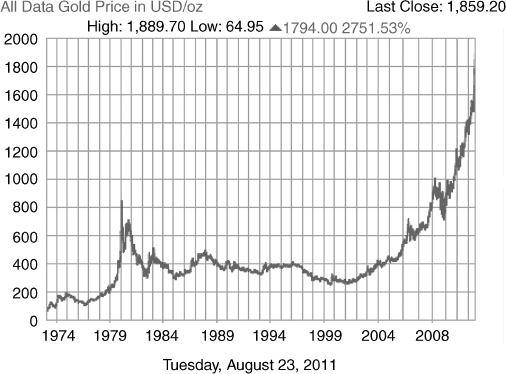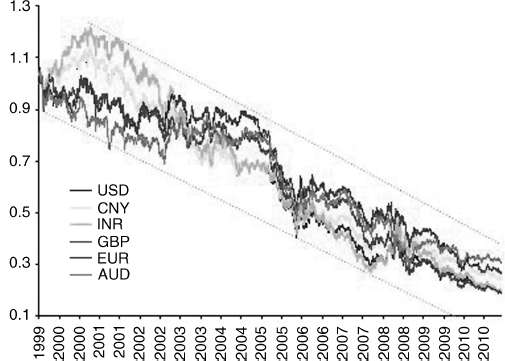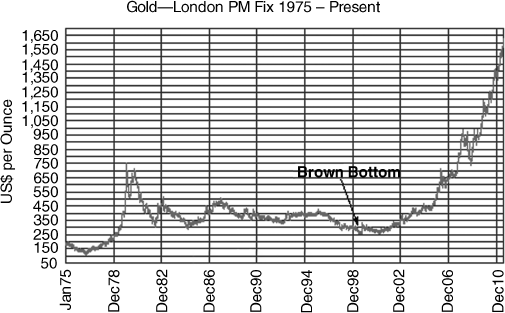Chapter 2
Bubble Enablers and Precipitating Factors
It is not enough to say that the markets in general are vulnerable to bouts of irrational exuberance. We must specify what precipitating factors from outside the markets themselves caused the markets to behave so dramatically.1
—Robert J. Shiller
In order to spot the gold bubble, we must first understand what a bubble is and what precipitating factors have caused a bubble to form specifically in gold.
Bubbles are generally the result of a number of contributing factors; they are usually not brought about by any one clearly distinguishable cause. The factors involved can range from monetary policy to popularity to technological shifts to emotions such as fear and greed and even to the lack of other investment alternatives. Understanding which factors have contributed to the formation and inflation of a bubble greatly increases our chances of correctly spotting, defining, and predicting that bubble. And in the case of gold, there are plenty of factors, enablers, arguments, and clues that make a bubble claim hard to dismiss.
A number of factors and causes have made a bubble in gold possible and perhaps partly inevitable.
Removal of the Fixed Price for Gold in 1968
The price of gold was fixed by the government for a significant period until 1968, when the process that allowed for gold price fluctuation—and eventually free-market pricing—began. This structural change, which allowed for gold prices to fluctuate based on supply and demand, can be regarded as a precipitating and an indirect causal factor of our current bubble. With gold prices exposed to market behavior and now susceptible to mass investor psychology, a bubble is increasingly possible. Even the historical importance of gold did not protect it from forming a bubble; on the contrary, its historical importance was one of the fundamental reasons that enabled it to form a bubble, as investors used its historical importance as a reason to buy gold. It is almost as if the arguments made by those buying gold are the exact reasons why gold is in a bubble.
Figure 2.1 shows how much gold has soared since the removal of a fixed price.
Poor Market Performance and Capital Diversion
The “lost decade” in the stock market, which began with the dot-com bubble era of the late 1990s through 2000, convinced many investors to look elsewhere for investment returns. With the market's volatility and bottom-line flat performance, stocks haven't been as appealing as real estate, oil, or gold at different stages over the same period. When the dot-com bubble burst, many investors lost faith in the stock market, thinking that there must be other investment opportunities that provide growth but limit the risk. They had thought that stocks were generally safe, but the collapse of the NASDAQ and tech stocks in general, followed by a drop in the broader markets, proved them wrong. It was time to look for something else. That something else turned out to be real estate.
But the housing market grew too quickly and turned into a bubble as well. Together with oil, commodities, and many emerging markets, housing utterly collapsed in 2007 to 2008, sending stock markets and financial powerhouses crashing down and once again losing money for investors. Similar to the argument now made by gold investors (that gold is a physical, tangible asset), the fact that houses and real estate are real, tangible assets did not save them from the implosion of the housing bubble.
Now that almost any investment choice had proved itself to be ineffective and dangerous, it was time for another try. Stocks kept falling, housing was now a black hole—it was time to bet on two of the biggest themes of the decade: the growing emerging markets such as China, Brazil, and India, and the constant threat of economic collapse and stock market panic. Ironically, gold makes sense as an investment both for sustained emerging market growth—as increasing wealth in growing countries will demand more gold—as well as for protection in case the market falls. In other words, it appears that gold prices can benefit from both global growth and economic collapse—but that is likely not the case.
I refer to this transfer from one hot investment theme to the next as “capital diversion.” As one investment collapses, individuals look for the next big thing; but as they move from one theme to the next, they simply transfer their speculative bets to a different asset and form a new bubble. Capital diversion is easily seen as investors move from technology stocks to housing to oil and now to commodities and gold. This capital diversion was warranted, since investors had to flee from plunging asset prices; but by diverting their money to the new theme, they have enabled a bubble in gold.
With the ups and downs of the stock market and economy since 2000, investors simply can't be certain of anything. Their investments aren't necessarily safe; the economy could come crashing down any day. Unemployment is not only the worst it's been in the post–World War II era, it is also not improving. U.S. debt is at an extreme, and U.S. domination as a world economic power is slowly deteriorating.
So what's the solution to this unending uncertainty? Invest in something that has a long track record of stability: gold. Gold has been used as a form of currency and value for thousands of years. Gold investors therefore claim that since gold has been a steady and globally accepted form of wealth, it will always be a worthwhile investment—especially in times of economic turmoil and uncertainty.
The problem with this argument, however, is that gold may never become worthless, but if billions of dollars of speculative money are invested in gold and send the price soaring, it could easily one day be worth less than it is today. In other words, it may not drop to zero (worthless), but it could easily lose half of its value or fall back down to its historical average—which is far below where we are today. Gold is an illusion of certainty in an uncertain world.
Stock market drops are not the only troubling concerns that encourage the buying of gold. Massive government debt and seemingly unsafe government actions when it comes to fiscal and monetary policy are also threatening the stability of world economies and markets. It appears that even governments have acted dangerously and frivolously, and have tremendously increased their risk of spiraling out of control.
All of this financial irresponsibility translates into highly at-risk financial systems. And if a country's financial system is at risk, so is its currency—especially if debt levels keep rising and more money keeps getting printed. Once again, gold seems to be the best solution for tumbling markets and unstable currencies. If fiat currencies are so easily manipulated and rely so heavily on countries with such unsafe financial behavior, gold may be the only true currency (though, as we will see, gold is a commodity, not a currency).
Emerging Market Growth and Demand
Emerging countries like China, Brazil, and India are expected to grow at tremendous rates over the coming years, far outpacing those countries already in the developed world. The growth taking place in these emerging markets will bring about the growth of a large and powerful middle class in these countries, which will in turn increase demand for goods and services.
In many ways, the fate of global economies relies on the success of the emerging markets. And so, too, on the price of gold, since the growing middle class will be able to afford and demand more gold and jewelry. The argument for continuing rising prices in gold sounds plausible, but are expectations too high? What if emerging markets don't grow as quickly as most investors expect them to? What if the price of gold has soared to a level at which it already prices-in the expected future demand? Would the price then correct itself to represent a more reasonable forecast?
The lack of true historically established methods of valuing an asset increase the probability of mispricings tremendously. Time and time again, bubbles have formed around assets that have no strong predecessors in valuation—tulip bulbs in the 1600s, Internet technology in the 1990s, and real estate in the first decade of the twenty-first century. Without an established, globally accepted method of valuing an investment, the doors are wide open for misunderstandings, false arguments, and costly mispricing.
Gold has no dividend, has its price based on fickle supply and demand, depends on multiple markets and currencies, and has seen such fluctuations over the past few decades that it is simply too difficult, if not impossible, to accurately predict its value. And that lack of more concrete pricing analysis greatly increases gold's chances of becoming highly mispriced.
The more widespread an investment becomes, the greater its chances of forming a bubble. Perhaps nothing has helped gold prices soar more than the introduction of gold exchange-traded funds (ETFs). Before ETFs, the main ways to invest in gold were limited to buying physical gold and jewelry, or through real commodity trading. The introduction of gold ETFs, most notably the GLD (the largest gold-holding ETF in the world), has made it much easier, more accessible, and more liquid to invest in gold. With gold now traded similarly to stocks, the number of investors and degree of speculation has increased exponentially. With the proper tools for investment now at the disposal of gold investors, a speculative bubble has become drastically more likely. Figure 2.2 shows gold's massive rise since the introduction of gold ETFs
Figure 2.2 Gold's Rise since the Introduction of Gold ETFs
Source: www.kitco.com, Chart Prophet LLC.
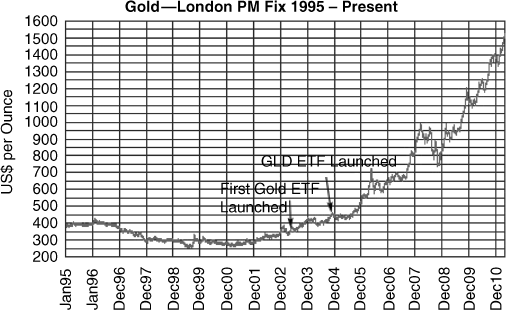
Former UK Prime Minister May Be Responsible for Gold Bubble
With the sale of over half of the UK's gold reserves from 1999 to 2002, when gold prices were at their lowest in 20 years, the man who later became Prime Minister prompted one of the worst financial blunders in recent history and launched the gold bubble that has lasted for over 12 years.
The gold bubble has undoubtedly involved a number of precipitating factors that have made the bubble possible—such as poor stock market performance, currency troubles, soaring debt, and even the introduction of gold ETFs. But at the core and source of every bubble is an initial boost that launches it. And in our case of the gold bubble, that initial boost was the decision made by former UK Prime Minister Gordon Brown to sell over half of the UK's gold reserves while gold was at its lowest prices in 20 years.
After a nearly 20-year bear market in gold, from the $850 an ounce high in January 1980 to a low of nearly $250 an ounce in mid-1999, UK Chancellor of the Exchequer Gordon Brown decided to sell more than half of the country's gold reserves and reinvest the proceeds in foreign currencies—including euros and dollars. The official reason given for this decision was to “achieve a better balance in the portfolio (the UK's reserve holdings) by increasing the proportion held in currency.”2 Although Brown's intention may have been to diversify the UK's reserves away from the tremendous weakness in gold that had persisted for over 19 years, his decision to sell the gold reserves was made at the worst possible time!
Announcing the UK government's plan on May 7, 1999, when the price of gold was $282.40 an ounce, Brown not only sold at almost the lowest price possible, but his advance notice of the significant upcoming sales drove down the price an additional 10 percent by the time of the first auction on July 6. Prices bottomed out at $252.80 on July 20, 1999 and have since soared to over $1,900. Gordon Brown's terrible decision, which saw the United Kingdom sell approximately 400 tons of gold in 17 auctions from July 1999 to March 2002—at an average price of $275 an ounce—has been called the Brown Bottom,3 since his plans to sell triggered “hysteria and a negative sentiment in the market,”4 drove gold prices even lower, and marked the lowest gold prices since 1979.
Moreover, Gordon Brown's exit from gold in order to reinvest proceeds into foreign currencies has been a terrible failure on both fronts. Not only is gold up over 600 percent since the United Kingdom sold its gold, but the currencies that Brown simultaneously decided to invest in are down tremendously over the same period.
Currencies have been in a clear and steep downtrend in comparison to gold since 1999, as shown in Figure 2.3. Meanwhile, the U.S. dollar has lost nearly 40 percent of its value since 2001, while gold has soared (see Figure 2.4).5
Figure 2.4 Twenty Years of the U.S. Dollar and Gold
Source: StockCharts, Doug Short/Twenty Years of the U.S. Dollar and Gold, Seeking Alpha.
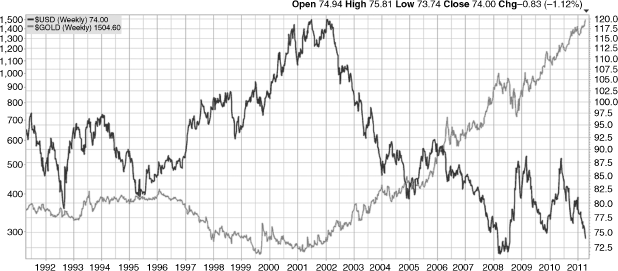
Brown's decision even went against the advice of the financial experts, who warned that the price of gold was nearing a multidecade low and that announcing the timing and amounts of gold sold through auction would plunge the price even further. Martin Stokes, former vice-president at JP Morgan, was surprised that the auction method was chosen, saying “it indicated they did not have a real understanding of the gold market.”6
The announcement of the upcoming gold sales also prompted a response from the most respected bank governors of other leading economies—Alan Greenspan and Jean-Claude Trichet. Greenspan, chairman of the U.S. Federal Reserve, defended gold, saying “gold still represents the ultimate form of payment in the world.” Trichet, governor of the Bank of France and later head of the European Central Bank (ECB), also defended gold, saying that according to France, Germany, Italy, and the United States, “the position is not to sell gold.”7
To make matters worse, 15 European central banks signed the Washington Agreement on Gold in September 1999, limiting the sale of gold to 400 tons per year. This pivotal decision by a powerful group of central banks to support gold prices marked a critical structural change in gold policy. In response to Gordon Brown's ill-timed and poorly executed announcement to sell the UK's gold reserves, the Central Bank Gold Agreement offered protection for gold prices, and even triggered a surge in gold prices from approximately $260 an ounce to around $330 an ounce in two weeks; prices have not dropped below their July 1999 lows.
Brown was the final large seller of gold after a 19-year gold bear market. Normally, using supply and demand logic, we'd expect the price of gold to drop due to the increased supply on the market. But since Brown's advance notice of large selling caused the bottom in gold prices as the last wave of panicked sellers sold their gold, Brown's large selling—rather than buying—was the initial boost that marked the beginning of the bubble. Moreover, Brown's actions caused other central banks to band together and support gold prices, essentially creating a floor and allowing the price of gold to consistently rise over time. This structural shift bolstered gold's price increases and allowed for the gold bubble to take off.
Started by Gordon Brown and confirmed by central banks around the world, the “Brown Bottom” (seen in Figure 2.5) marked the end of the gold bear market and the beginning of the gold bubble, which has been accompanied by parabolic price increases, overspeculation, and extreme expectations.
Perhaps the most dangerous of all of gold's qualities is the illusion engendered among investors that gold is a steady asset and store of value with a high degree of safety. It is assumed that since gold has always been a store of value throughout centuries, and through rises and falls of civilizations, that it is therefore stable. It is assumed that gold performs well during both inflationary and deflationary times. But as we will see in future chapters, it is largely ignored that the value of gold can and has dropped significantly in the past, and has done so both in inflationary and deflationary times. Gold may never lose its entire value, but it can surely lose a significant chunk of it. For those who define “safe” as “safe from severe losses,” however, gold is by no means safe.
We have discussed why gold's historical significance and related outside factors enabled the justification for buying gold in order to protect and profit. The removal of the fixed price for gold enabled free-market pricing that is vulnerable to market psychology, poor stock market performance caused investors to lose faith and look to gold for protection and return, economic uncertainty prompted investors to falsely rely on a surefire and “certain” asset backed by history, massive devaluation of currencies created a panic and loss of faith in paper currency, emerging market growth and the huge expected demand for commodities has inflated gold prices, the lack of true historical valuation metrics has greatly increased the probability of costly mispricings, the introduction of gold ETFs has sparked vast speculation in gold and allowed a monstrous-sized wave of new investors to buy gold, and structural changes have turned gold into an unsafe haven driven by misconceptions and delusion.
Now that we understand the arguments made by gold investors and what factors have caused them to view gold as the solution, we can point out all of the clues and warning signs that indicate a massive gold bubble on the verge of collapse.
